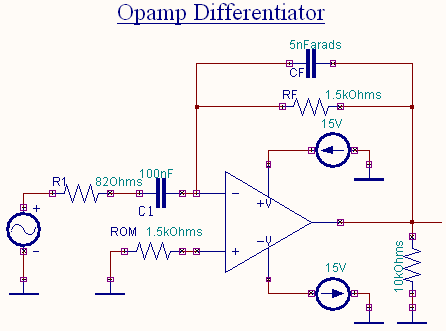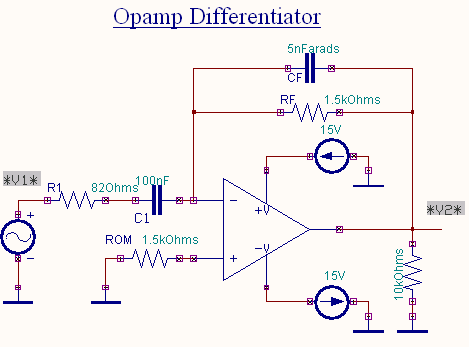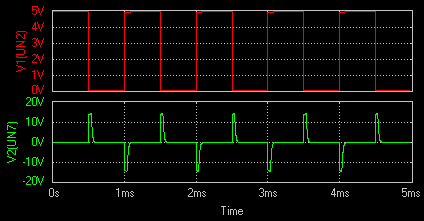Opamp Differentiator
Aim
To design and simulate a Differentiator circuit using opamp.
Components
|
Name
|
EDWin Components Used |
Description |
Number of components
required |
| RES |
RC05 |
Resistor |
4 |
| CAP |
CASE-A600 |
Capacitor |
2 |
| OPAMP |
741A |
Comparator |
1 |
| VGEN |
VGEN |
Ac voltage source |
1 |
| VDC |
VDC |
Dc voltage source |
2 |
| GND |
SPL0 |
Ground |
5 |

Theory
A circuit in which output
waveform is the derivative of the input waveform is known as the differentiator or the
differentiation amplifier. Such a circuit
is obtained by using operational amplifier in the inverting configuration connecting a
capacitor, C1 at the input.
Applying KCL the expression for output voltage is obtained as follows.

Since 


But  because A is
very large. Therefore
because A is
very large. Therefore


Thus the output vo is equal to RFC1
times the negative instantaneous rate of change of the input voltage vin
with time. The gain of the circuit  increases with increase in frequency at a rate of 20 dB/decade. This makes the circuit
unstable. Also the input impedance XC1 decreases with increase in frequency which makes
the circuit susceptible to high frequency noise. When amplified the noise
can completely override the differentiated output signal. The
frequency at which gain is zero dB is given by
increases with increase in frequency at a rate of 20 dB/decade. This makes the circuit
unstable. Also the input impedance XC1 decreases with increase in frequency which makes
the circuit susceptible to high frequency noise. When amplified the noise
can completely override the differentiated output signal. The
frequency at which gain is zero dB is given by

The stability and high frequency noise problems can be corrected by the
addition of two components:- R1 and CF. The gain
limiting frequency fb isgiven by

R1CF and RFCF
make the circuit more stable by preventing the increase in gain with frequency. The value
of fb and in turn R1C1
and RFCF values should be selected such that fa<fb<fc where 

and fc is the unity gain bandwidth of the
opamp. Thus the input signal will be differentiated properly if the time
period of the input signal is larger
than or equal to RFC1
i.e.  .
.
Procedure
EDWinXP -> Schematic Editor: The circuit diagram is drawn by loading components
from the library. Wiring and proper net assignment has been made. The values are assigned for relevant
components.

EDWinXP> Mixed Mode Simulator: The circuit is preprocessed. Waveform markers are placed at
the input and output of the circuit. GND net is set as reference net. The Transient Analysis parameters have been
set. The Transient Analysis is executed and output waveform is observed in the Waveform Viewer.
Result
The output waveform may be observed in the waveform viewer.
